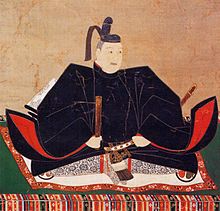Tokugawa Hidetada
Tokugawa Hidetada ( Jap. 徳川秀忠 * thirtieth July 1579 as Tokugawa Takechiyo ( 徳川竹千代 ); † 14. March 1632 ) was the second Tokugawa - Shogun . He ruled from 1605 to 1623 and was the third son of the founder of the Tokugawa shogunate, Tokugawa Ieyasu . Although he had left him the office of Shogun in 1605, he did not give up the actual power until his death.
Tokugawa Hidetada took part in the siege of Osaka Castle , but the military leadership was held by his father, who at that time held the office of Ōgosho .
The goal of the siege was the final submission of the Toyotomi clan, who had entrenched themselves in Osaka with 113,000 soldiers under the leadership of Toyotomi Hideyori , son and successor of Toyotomi Hideyoshi . The Tokugawa clan was deployed with 194,000 soldiers. There were several battles beginning in the summer of 1614 at the mouth of the Kizugawa River and ending with an attack by Hideyori in the winter of 1615 known as the Battle of Tennoji . Ultimately, the Tokugawa clan emerged victorious from the siege and the last of the Toyotomi were killed.
Later in 1615, Hidetada enacted laws regulating the life of samurai ( buke shohatto laws) and established the Imperial Court of Justice ( kuge shohatto laws).
Tokugawa Hidetada resigned in 1623 and left his eldest son Tokugawa Iemitsu as shogun, but he remained in power until his death in 1632.
| personal data | |
|---|---|
| SURNAME | Tokugawa, Hidetada |
| ALTERNATIVE NAMES | 徳 川 秀 忠 (Japanese); 徳 川 竹 千代 (Japanese, childhood name); Tokugawa Takechiyo (childhood name) |
| BRIEF DESCRIPTION | Japanese shogun |
| DATE OF BIRTH | July 30, 1579 |
| DATE OF DEATH | March 14, 1632 |
